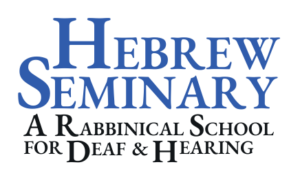By Hebrew Seminary President Rabbi Dr. Douglas Goldhamer
Our God has many names. In his great philo-mystical text, Otzrot Chaim, Rabbi Chaim Vital writes that there arose “a desire” within the center point of the Ayn Sof. This desire of the Ayn Sof was that He wanted to be called by “His Names.” As Rabbi Vital says, “How can God be called “The Merciful” if He has no one to whom He can show mercy?” This is so with all the other names by which the Creator is known. And so, Rabbi Vital maintains that the purpose of creation was for God to bring into actuality the names that only potentially existed in the Ohr Pashut of the Ayn Sof.
With this in mind, we gain a deeper insight into the opening verses of this week’s Torah portion Va’era, especially Chapter 6:2, “And God spoke to Moses and said, “I am YHVH. Now I have appeared to Abraham and Isaac and Jacob [by the name] El Shaddai, but by my name YHVH, I was not known to them.” Rabbi Yaakov Yosef of Polennoye, in his famous Hasidic text Toledot Yaakov Yosef, writes in his commentary to Va’era, “I heard from my teacher [Baal Shem Tov} that the tzaddikim are emissaries of the Matrona [the Matrona is a kabbalistic name for the Shechinah, the Feminine Presence of God]. Because of their own lack, whether of food or clothing, the tzaddikim recognize that there is a corresponding lack above. They pray for this lack above to be rectified. They do not pray for their own benefit.”
The Toledot Yaakov Yosef maintains here that human needs are projected onto the Shechinah, and thus prayer is not self-serving, but for the purpose of removing the Shechinah’s need or suffering.
We also learn in Talmud Sanhedrin 46a, when a man suffers punishment, the Shechinah responds, “My head hurts, my hand hurts.” The man will then pray to alleviate the Shechinah’s suffering, thereby banishing his own suffering.
Kabbalah teaches that there is a direct correspondence between the Shechinah and the community of Israel.
The name Shechinah is derived from the Hebrew root “SHACHAN” which means “to dwell.” Through history, the Shechinah became the wandering Divine Presence. She resided in the tent in pre-temple times, in a dwelling that was not permanent, but temporary and ready to move. After our temple was destroyed in 586 BCE, the Shechinah meant the dwelling and immanent Presence of God.
Philosophically, the Divine Presence which informs all things is a light and an energy flow vitalizing and sustaining everything. The Shechinah is a Divine Presence, unifying everything. We, the community of Israel, know this Feminine Presence by dwelling in Her. In meditative prayer, we pray and do kavvanot or meditations, to dwell in Her Presence. The Shechinah is the aspect of God that is intimately connected with the souls of the community of Israel. All Jewish souls are bound together as one single being.
Much of the work I do is meeting with members of my congregation and praying with them for healing. I do this regularly many times every day, with individual families, who have been hurt by disease. I often work closely with their physicians, combining Kabbalistic modalities with biological treatments that are managed by their doctors.
You see, when someone is ill, she or he feels a tremendous sadness or even depression. This causes the person who is suffering disease to feel alone, separated, and even in exile, like the Shechinah, who is said to be dala va-anya, “needy and poor.” But just as the Shechinah is the community of Israel, every member of my congregation, indeed every Jew, is intimately connected to every other soul of Israel. We are one. We all dwell in the Shechinah.
I share with my parishioners how the Shechinah suffers, together with those who experiences a certain disease. When we focus on how the Shechinah suffers together with us, when we identify our pain with Hers, we are no longer alone. When, through mystical meditations, my parishioner becomes aware of the Oneness of everything, the Oneness of the Ayn Sof, he or she begins true healing, true physical healing.
When we see not only ourselves suffering, but when we see all those who suffer a dreadful disease as one collective group, and we pray for the well-being of others who are hit with this disease, and do kavvanot or meditations, that are taught by the great Jewish Kabbalists. I have seen people with terrible diseases begin physical healing. When we pray this way, we are also praying for the Shechinah, because we are intimately connected with Her. And so, in our healing prayers, we ask Hashem to heal us “for Your sake.” We pray for the Shechinah. In this way, we become a vessel drawing in Divine Light and Healing, for ourselves and others. Not only does good health and prosperity inspire us to discover divinity, but suffering also helps us greatly in finding God and in achieving healing.
Clearly, healing does not instantly come about when we recognize all of this. But when we understand these insights, by the Toledot Yaakov Yosef, and apply specific spiritual exercises related to these insights, on a regular and daily basis, we can see great healing take place. I have seen this with the members of my congregation. When we learn to pray “for Your sake,” amazing results take place.
Naturally, this involves regular daily prayer and meditations and the great input from contemporary medicine—but the results are phenomenal. The opening verses of this week’s Torah portion are medicine for the soul and body. All truths are found in this remarkable book, the Torah that God has given us. He truly is a loving, caring compassionate healing God. Amen.
Rabbi Dr. Douglas Goldhamer is senior rabbi of Congregation Bene Shalom, Skokie and president and professor of Jewish Mysticism at Hebrew Seminary, Skokie.

Leave A Comment
You must be logged in to post a comment.